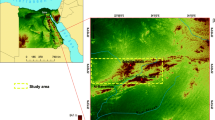Summary
High resolution isothermal remanent magnetisation (IRM) acquisition was performed on forty-one Chinese loess samples with the aim of investigating the effects of weathering on the remanence carrying mineralogy. Magnetic susceptibility was taken as a measure of the degree of weathering. This is a valid assumption based on previous studies which have demonstrated a close relationship between climate and magnetic susceptibility in the Chinese loess. Detailed analysis, based on fitting accumulative log-gaussian curves to IRM acquisition data, reveals up to four distinct coercivity components. The remanences of the two harder coercivity components are found to be almost independent of magnetic susceptibility. On the other hand, the remanences of the two softer coercivity components are found to be positively correlated with magnetic susceptibility. Most probably the two harder components are associated with detrital iron-oxides in the primary dustfall, whereas the softer components were created during pedogenesis.
Similar content being viewed by others
References
Day R., Fuller M. and Schmidt V.A., 1977: Hysteresis properties of titanomagnetites: grain-size and compositional dependence.Phys. Earth Planet. Int. 13, 260–267.
Derbyshire E., Keen D.H., Kemp R.A., Rolph T.A., Shaw J. and Meng X., 1995: Loess-palaeosol sequences as recorders of palaeoclimate variations during the last glacial-interglacial cycle: Some problems of correlation in north-central China. In: E. Derbyshire (ed.),Wind blown sediments in the Quaternary record, Quaternary Proceedings, pp. 7–18, John Wiley & Sons Ltd., Chichester.
Dunlop D.J., 1971: Magnetic properties of fine-particle hematite.Ann. Geophys. 27(3), 269–293.
Evans M.E. and Heller F., 1994: Magnetic enhancement and palaeoclimate: Study of a loess/palaeosol couplet across the Loess Plateau of China.Geophys. J. Int. 117, 257–264.
Eyre J.K. and Shaw J., 1994: Magnetic enhancement of the Chinese loess — the role of γFe2O3.Geophys. J. Int. 117, 265–271.
Forster T., Evans M.E. and Heller F., 1994: The frequency dependence of low field susceptibility in loess sediments.Geophys. J. Int. 118, 636–642.
Heller F. and Liu T., 1986: Palaeoclimate and sedimentary history from magnetic susceptibility of loess in China.Geophys. Res. Lett. 13, 1169–1172.
Hunt C.P., Banerjee S.K., Han J., Solheid P.A., Oches E., Sun W. and Liu T., 1995: Rock-magnetic proxies of climate change in the loess-palaeosol sequences of the western Loess Plateau of China.Geophys. J. Int. 123, 232–244.
Kukla G., and An Z., 1989: Loess stratigraphy in Central China.Palaeogeogr. Palaeoclimatol. Palaeoecol. 72, 203–225.
Kukla G., Heller F., Liu X.M., Xu T.S. and An Z.S., 1988: Pleistocene climates in China dated by magnetic susceptibility.Geology 16, 811–814.
Maher B.A., 1988: Magnetic properties of some synthetic sub-micron magnetites.Physical Journal 94, 83–96.
Robertson D.J. and France D.E., 1994: Discrimination of remanence-carrying minerals in mixtures, using isothermal remanent magnetisation acquisition curves.Phys. Earth Planet. Inter. 82, 223–234.
Rolph T.C., Shaw J., Derbyshire E. and Wang J., 1993: The magnetic mineralogy of a loess section near Lanzhou, China. In: K. Pye (ed.),The Dynamics and Environment Context of Aeolian Sedimentary Systems. Special publication No. 72, pp. 311–323, Geological Society.
Zheng H., Rolph T., Shaw J. and An Z., 1995: A detailed palaeomagnetic record for the last interglacial period.Earth Planet. Sci. Lett. 133, 339–351.
Zhongli D., Rutter N. and Liu T., 1993: Pedostratigraphy of Chinese loess deposits and climate cycles in the last 2·5 Myr.Catena 20, 73–91.
Author information
Authors and Affiliations
Rights and permissions
About this article
Cite this article
Eyre, J.K. The application of high resolution IRM acquisition to the discrimination of remanence carriers in Chinese loess. Stud Geophys Geod 40, 234–242 (1996). https://doi.org/10.1007/BF02300740
Received:
Revised:
Issue Date:
DOI: https://doi.org/10.1007/BF02300740




